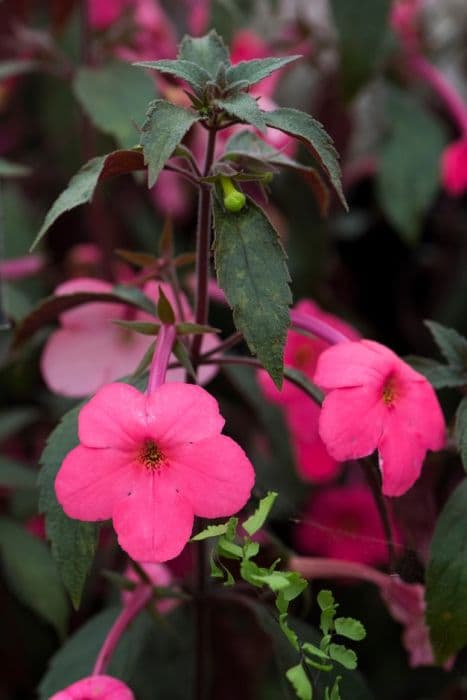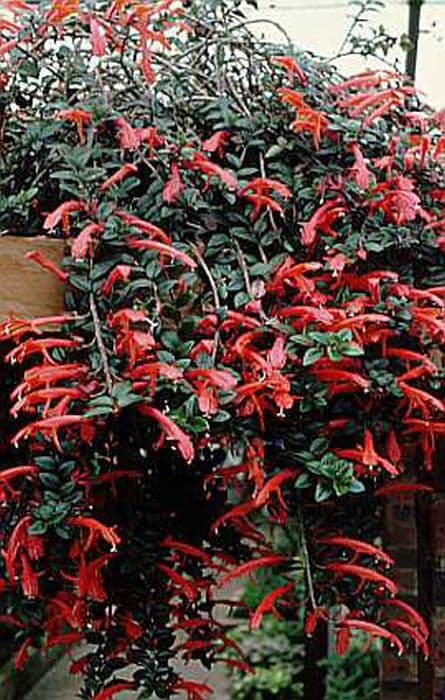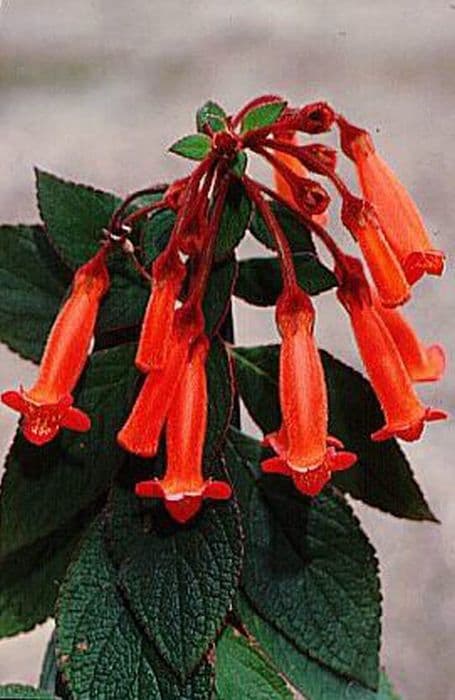Cape Primrose Streptocarpus 'Susan'

ABOUT
Streptocarpus 'Susan', commonly known as Cape Primrose, is an attractive houseplant with a distinctly lush and decorative appearance. Its foliage consists of soft, velvety leaves that are elongated and often have a deep green color, which can create a striking contrast with the flowers. These leaves typically grow in a rosette pattern, spreading outwards from the base of the plant elegantly. The Cape Primrose is particularly known for its beautiful blooms, which emerge on slender, upright stalks. The flowers are shaped like trumpets or funnels and boast a vibrant palette that may include shades of purple, pink, blue, or white, often with intricate throat markings or a gradient effect that enhances their visual appeal. The blossoms are delicate and can be profuse under the right conditions, forming a canopy of color above the leafy base. Overall, Streptocarpus 'Susan' has a graceful and charming presence, making it a beloved choice for indoor gardening enthusiasts seeking to add a touch of botanical beauty to their living spaces.
About this plant
 Names
NamesSynonyms
Cape Primrose, Streptocarpus, African Violet Cousin
Common names
Streptocarpus 'Susan'.
 Toxicity
ToxicityTo humans
The Cape Primrose, with the specific cultivar name 'Susan', is generally not considered toxic to humans. There are no well-documented symptoms of poisoning because it is not known to be poisonous. Therefore, ingesting parts of the Cape Primrose is not expected to result in any significant toxic consequences in humans.
To pets
The Cape Primrose, including the 'Susan' cultivar, is also generally considered non-toxic to pets, including common household pets like cats and dogs. There are no specific documented symptoms of poisoning as it is not known to be a poisonous plant. Ingesting parts of the Cape Primrose should not cause harmful effects to pets. However, it is always prudent to prevent pets from eating plants, as individual sensitivity or a physical reaction to non-toxic plants can vary among animals.
 Characteristics
CharacteristicsLife cycle
Perennials
Foliage type
Evergreen
Color of leaves
Varies
Flower color
Mixed
Height
1 foot (30 cm)
Spread
1 foot (30 cm)
Plant type
Herb
Hardiness zones
10
Native area
Africa
Benefits
 General Benefits
General Benefits- Easy to Care For: Streptocarpus 'Susan' is known for being low-maintenance, making it a convenient choice for both novice and experienced gardeners.
- Long Bloom Period: It typically has a long flowering season, often blooming for several consecutive months.
- Compact Size: Its compact growth habit makes it an excellent option for indoor spaces and small gardens.
- Aesthetic Appeal: The plant adds visual interest to any setting with its vivid blooms and attractive foliage.
- Versatile: Cape Primrose can be grown in a variety of indoor conditions, from windowsills to terrariums.
 Medical Properties
Medical PropertiesThis plant is not used for medical purposes.
 Air-purifying Qualities
Air-purifying QualitiesThis plant is not specifically known for air purifying qualities.
 Other Uses
Other Uses- Artistic inspiration: The vibrant colors and patterns of Streptocarpus 'Susan' can serve as inspiration for artists and designers, offering natural shapes and tones to incorporate into textiles, paintings, and other decorative arts.
- Educational tool: This plant can be used in botany classes to teach about the Gesneriaceae family, demonstrating key characteristics such as its growth habit and flower structure.
- Photography subject: Due to its striking appearance, Streptocarpus 'Susan' is an excellent subject for macro photography, helping photographers to practice focus and composition with its intricate details.
- Themed gardens: Streptocarpus 'Susan' can be utilized in garden designs that focus on a specific theme, such as a Victorian garden or a purple-themed space, due to its distinctive flower colors.
- Container gardening: This plant is well-suited for container gardening, allowing gardeners in urban settings or with limited space to enjoy its beauty on patios, balconies, or indoors.
- Social events: The flowers of Streptocarpus 'Susan' can be used in table settings and decor for special events and gatherings, adding a touch of natural elegance.
- Horticultural shows: Gardeners can grow Streptocarpus 'Susan' for display in plant and flower shows, where its form and color might win awards and recognition.
- Watercolor painting: The delicate flowers provide an ideal subject for watercolor artists looking to capture the translucence and softness of petals in their artwork.
- Gift plant: Due to its ease of care and long-lasting blooms, Streptocarpus 'Susan' is an excellent choice as a gift for plant lovers or even as a housewarming present.
- Companion planting: When planted alongside other shade-loving plants in outdoor beds or indoor plant arrangements, Streptocarpus 'Susan' can help create visually appealing and diverse displays.
Interesting Facts
 Feng Shui
Feng ShuiThe Cape Primrose is not used in Feng Shui practice.
 Zodiac Sign Compitability
Zodiac Sign CompitabilityThe Cape Primrose is not used in astrology practice.
 Plant Symbolism
Plant Symbolism- Persistence: Streptocarpus, commonly known as Cape Primrose, often symbolizes persistence due to its ability to bloom repeatedly throughout the year with the proper care.
- Endurance: This plant can endure in low-light conditions, representing the ability to thrive in less-than-ideal circumstances, and thus symbolizing endurance.
- Optimism: The bright and varied colors of Cape Primrose blooms signify a sense of optimism and joy, making it a pleasant gift to lift spirits.
- Longevity: With proper maintenance, Cape Primroses can live and bloom for many years, which can be seen as a symbol of longevity and lasting presence.
- Diversity: The wide variety of species within the Streptocarpus genus signifies diversity and adaptability, as these plants can adapt to various environments and conditions.
 Water
WaterCape Primrose should be watered when the top inch of soil feels dry to the touch, typically every 5 to 7 days, depending on environmental conditions. Use room temperature water, watering the plant thoroughly until water runs freely from the drainage holes. It is best to water Cape Primrose with about one to two pints of water, ensuring even soil moisture but avoiding waterlogged conditions. Allow the pot to drain completely and never let the plant sit in water as this can lead to root rot. Adjust the amount of water during different seasons, giving less during winter when plant growth naturally slows down.
 Light
LightCape Primrose thrives in bright, indirect sunlight. It should be placed in a spot where it can receive plenty of light but be shielded from the direct rays of the sun, such as near a north-facing window or a few feet away from an east or west-facing window. Direct sunlight can scorch the leaves, while too little light can cause weak, leggy growth.
 Temperature
TemperatureCape Primrose prefers a temperature range between 60 and 75 degrees Fahrenheit but can survive temperatures as low as 50 and as high as 80 degrees Fahrenheit. Ideally, maintain a consistent temperature to prevent stress to the plant. Sudden temperature fluctuations and drafts should be avoided to keep the plant healthy.
 Pruning
PruningPrune Cape Primrose to remove faded flowers and yellowing leaves regularly to encourage bushier growth and more blooms. The best time for heavy pruning is in late winter or early spring before new growth begins. Prune the plant every few months to maintain shape and remove any leggy or overgrown stems to promote a more compact form.
 Cleaning
CleaningAs needed
 Soil
SoilThe best soil mix for a Cape Primrose (Streptocarpus 'Susan') should be light, well-draining, and rich in organic matter, with a mix of peat, perlite, and vermiculite or similar materials being ideal. A slightly acidic to neutral pH between 6.0 and 7.0 is preferred to ensure healthy growth.
 Repotting
RepottingCape Primroses should be repotted annually to rejuvenate the soil and provide room for growth. They tend to do best when not overly root-bound, so increasing the pot size if necessary during repotting can help maintain plant health.
 Humidity & Misting
Humidity & MistingCape Primroses thrive in environments with high humidity, generally between 40% to 60%. If the air in your home is dry, consider using a humidifier or a pebble tray with water to maintain these humidity levels around the plant.
 Suitable locations
Suitable locationsIndoor
Keep in indirect light, water when soil feels dry.
Outdoor
Protect from strong sun, sheltered spot, frost-free.
Hardiness zone
10-11 USDA
 Life cycle
Life cycleStreptocarpus 'Susan', commonly known as Cape Primrose, begins its life as a seed, which upon germination, sprouts into a small seedling with a rosette of leaves. As it enters the vegetative stage, the plant develops larger leaves and starts to establish a stronger root system. With proper light, water, and nutrients, it reaches maturity and enters the flowering stage, during which it produces vibrant, tubular flowers that attract pollinators. After pollination, it sets seed which can be dispersed in the immediate vicinity or by human intervention. As a perennial, Cape Primrose can continue to grow and bloom for several years, provided it is not subjected to freezing temperatures. Over time, older leaves may die back, and the plant may need to be divided or propagated through leaf cuttings to rejuvenate and maintain its vitality.
 Propogation
PropogationPropogation time
Spring-Early Summer
The most popular method of propagating Streptocarpus 'Susan', commonly known as Cape Primrose, involves leaf cuttings. This process is generally most successful when performed in the spring or early summer, which coincides with the plant's active growth period. To propagate Cape Primrose by leaf cuttings, a healthy and mature leaf is selected and cleanly cut across the width. The leaf is then divided into sections, each about 2-3 inches (approximately 5-7.5 centimeters) in length, ensuring that each section has a vein. These sections are placed on the surface of a moistened, well-draining potting mix, pressing them in just enough so that they are supported upright. Roots and new plants will eventually form at the base of the petiole or along the cut veins, which can be potted separately once they've grown sufficiently.









